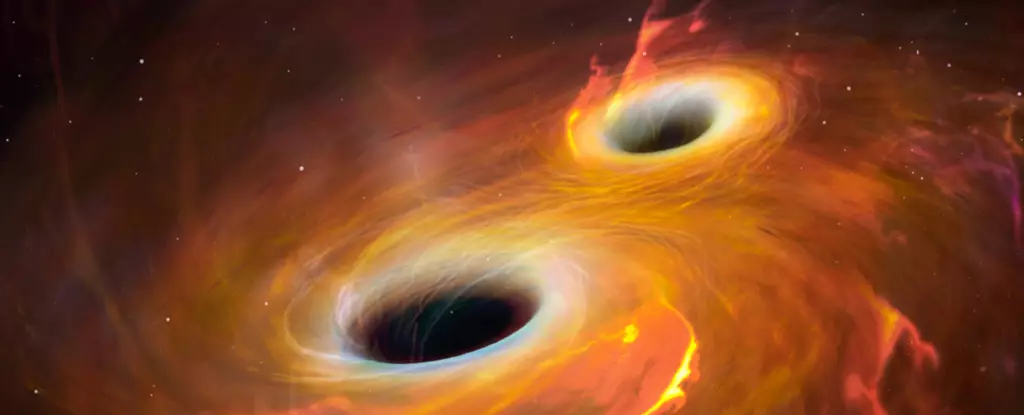The cosmos is an intricate tapestry, a chaotic dance of stellar bodies and enigmatic phenomena. At the heart of our Milky Way galaxy lies a supermassive black hole known as Sagittarius A*. What makes this region particularly fascinating is not just the black hole itself but the staggering variety of celestial objects that orbit it, including young stars, gas clouds, dust, and potentially many undetected stellar-mass black holes. This bustling hub of activity is enveloped in a shroud of interstellar material, rendering it invisible through conventional visible-light observation. Instead, astronomers must delve into the realms of infrared and radio observations to glean insights into this cosmic crucible.
The Veil of Mystery: Observational Challenges
The interstellar gas and dust surrounding Sagittarius A* serve both as a protective cloak and a formidable barrier to understanding the true nature of this chaotic region. While we can spot some stars through infrared and radio wavelengths, stellar-mass black holes remain among the most elusive objects in astrophysics. Their presence has long been surmised, yet measuring their actual numbers poses significant challenges. Traditional models estimate as few as 300 black holes reside within a close proximity to the supermassive black hole, while alternative theories speculate that the very existence of Sgr A* could have instigated the birth of countless stellar-mass black holes.
Recent research published in *Astronomy & Astrophysics* challenges the more conservative estimates and presents a bold new model. This innovative view posits that the extraordinary density of gas and dust surrounding Sgr A* fosters the rapid formation of large O-type and B-type stars. These massive stars have notoriously short lifespans, ending in dramatic supernovae that eventually collapse into black holes. The idea is that each cycle of stellar births and deaths within this dense environment would lead to an accumulation of significant quantities of black holes, possibly leading to a region filled with millions or even billions within each cubic parsec.
The Star Grinder Concept: A New Paradigm in Stellar Evolution
Dubbed the “star grinder,” this new model offers a fresh perspective on the dynamic interplay of stars and black holes at the galactic center. If this theory holds, the consequences are monumental. The central region would be a veritable death trap for stars venturing too close to the chaotic gravitational forces at play, where collisions between stars and black holes could become commonplace. This constant churn may not only accelerate the formation of new stars but also catalyze the birth of new black holes, creating an accelerating cycle of stellar generation and destruction.
Yet, despite the compelling nature of the star grinder model, the challenge remains: how to validate these claims? The authors of the study propose a statistical method grounded in the concept of collision time. This concept revolves around the average duration before a star and a black hole collide, a value that hinges upon the density of black holes and the size of the stars in question. With more black holes in a given area, the likelihood of a star encountering one dramatically increases, suggesting a high collision frequency would exist in the dense environment surrounding Sgr A*.
Deciphering Stellar Dynamics: Observational Evidence
To test the star grinder hypothesis, researchers compared theoretical calculations of collision times with observational data. They focus primarily on the largest stars—O-type stars—their relatively small numbers providing insight into their vulnerability to black hole collisions. Sparse presence in the central region indicates they may be getting “ground up” by the significant population of black holes lurking there. Conversely, the abundance of smaller B-type stars suggests they have a less perilous path, encountering fewer black holes in their stellar journeys.
Based on this analysis, researchers propose there may be around 100 million stellar-mass black holes within each cubic parsec near Sagittarius A*. This revelation not only enhances our understanding of black hole density in our galaxy’s core but also offers explanations for other cosmic phenomena, such as hypervelocity stars. These stars zipping through our galaxy at incredible speeds may find their genesis in close interactions with black holes, providing further layered complexity to our understanding of stellar dynamics.
The star grinder model reshapes our knowledge of the galactic center, forcing us to confront an elaborate web of stellar births, deaths, and the invisible threads of black holes weaving through it all. These findings compel us to re-imagine the chaotic beauty of our universe—where life and death are merely two faces of the same cosmic coin, eternally spinning in the infinite dance of existence. As we continue to explore the mysteries of our galaxy, one thing is certain: the heart of the Milky Way holds more secrets than we can currently fathom, waiting for the curious minds of tomorrow to decipher.


Leave a Reply